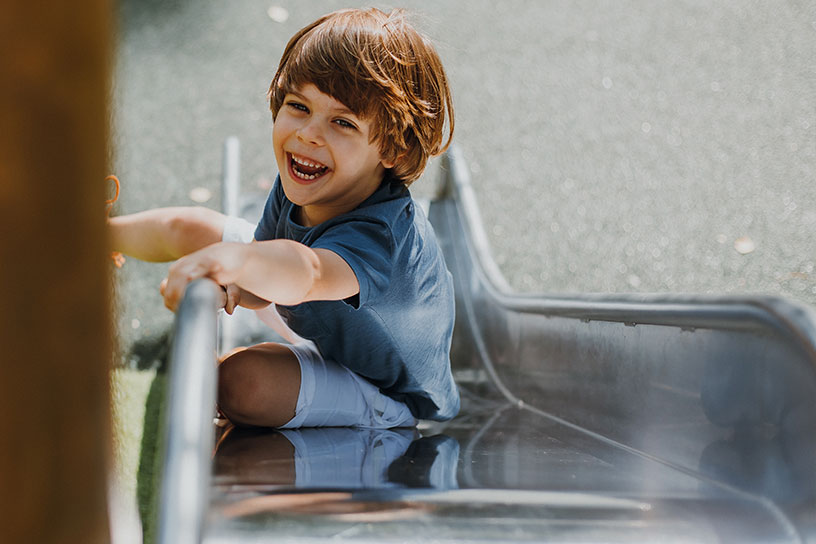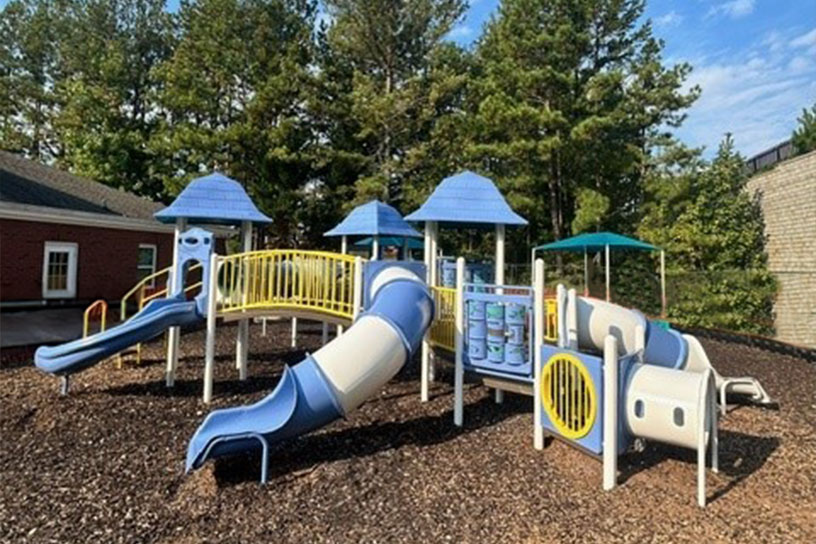Playgrounds are vibrant spaces that provide children with opportunities for physical activity, social interaction, and imaginative play. When planning a playground build, prioritizing safety is paramount. From selecting the site to choosing equipment and maintaining the playground, numerous factors must be considered to create a safe and enjoyable environment for children. Let's explore some essential considerations for safety when planning a playground build.
Selecting the Site
Choosing the right location for your playground is crucial. Consider the following factors:
- Shading
Ensure the site has natural or artificial shading to protect children from excessive sun exposure, especially during hot summer months. This helps prevent sunburn and dehydration.
Playground Layout
The layout of the playground plays a significant role in ensuring safety. Take the following factors into account:
- Accessibility
When planning an inclusive playground, prioritize accessibility for children of all abilities. Incorporate wheelchair-accessible ramps, paths, and entrances. Include transfer platforms and swings for easy access. Create sensory play opportunities and provide handrails for support. Choose suitable ground surfacing and consider visual and auditory accessibility. Consult with experts in inclusive design. By designing an inclusive playground, you foster social integration and create a welcoming space for all children to play and interact together. - Age Separation
Ensure age-appropriate play experiences and prevent collisions by separating the playground into designated areas for toddlers, preschoolers, and older children. Install suitable equipment and activities for each age group. Use signage and barriers to guide children and caregivers. Provide supervision in each area to ensure safety. Age separation promotes safe and enjoyable play for all children. - Conflicting Activities
When planning a playground build, it is crucial to carefully consider the layout to minimize conflicts between different activities. This proactive approach helps prevent collisions and reduces the risk of injuries. Here's how you can address conflicting activities:- Strategic Placement - Arrange the placement of play equipment in a way that minimizes potential conflicts. For example, ensure that swing sets are placed away from slide exits or other high-traffic areas. By providing ample space and separation between different activities, children can engage in their play without interfering with others.
- Traffic Flow - Plan the flow of foot traffic within the playground to avoid congested areas. Consider creating separate pathways for entrance and exit points, and ensure they do not intersect with areas where children are actively playing. This helps maintain a smooth and organized flow of movement, reducing the likelihood of accidents.
- Sight Lines
Clear sight lines are essential for effective supervision and maintaining a safe environment in the playground. Consider the following:
- Obstruction Removal - Ensure that bushes, trees, or any other vegetation do not obstruct sight lines across the playground. Regularly trim vegetation or position play equipment in a way that maintains unobstructed views for caregivers and supervisors.
- Strategic Placement of Structures - When placing play structures, consider the sight lines they may create. Avoid obstructing visibility to other areas of the playground, particularly where potential conflicts or hazards might occur. Proper placement allows for better supervision and timely intervention if necessary.
- Obstruction Removal - Ensure that bushes, trees, or any other vegetation do not obstruct sight lines across the playground. Regularly trim vegetation or position play equipment in a way that maintains unobstructed views for caregivers and supervisors.
- Signage and/or Labeling
Installing clear signage and labels in the playground is crucial for providing guidance, communicating safety rules, and enhancing overall safety. Here are key considerations:- Age Appropriateness - Use signage to clearly indicate which areas or equipment are suitable for specific age groups. This helps parents and caregivers direct children to age-appropriate play areas, ensuring they engage in activities suitable for their developmental stage.
- Safety Rules - Display signage that communicates important safety rules, such as no running on certain surfaces or using equipment in a specific manner. Reinforce proper behavior and highlight potential hazards to promote safe play.
- Equipment Usage Guidelines - Provide clear instructions and guidelines on how to use specific equipment, especially if they require proper techniques or precautions. This ensures that children understand how to use the equipment safely and reduces the risk of accidents or misuse.
Selecting Equipment
Choosing the right equipment is crucial for a safe playground. Consider the following factors:
- Surfacing
Protective surfacing beneath playground equipment is essential to minimize injuries from falls. Ensure all play structures have suitable protective surfacing, including areas around swings, slides, and climbers. Choose appropriate surfacing materials such as rubber mulch, engineered wood fiber, or synthetic turf that meet safety standards and provide adequate cushioning.- Material Selection - Opt for high-quality materials that are known for their durability. Common materials used in playground equipment include metal, plastic, and wood. Each material has its own strengths and considerations. Metal, such as stainless steel or galvanized steel, is known for its strength and resistance to rust and corrosion. Plastic materials, like high-density polyethylene (HDPE), are durable, low-maintenance, and resistant to fading or cracking. Wood, when properly treated and maintained, can be a durable option, but it may require more regular upkeep to prevent rotting or splintering.
- Weather Resistance - Choose equipment and materials that can withstand various weather conditions, including exposure to sunlight, rain, snow, and temperature fluctuations. Look for materials that are UV-resistant, moisture-resistant, and have protective coatings or treatments to enhance their longevity. Ensuring that the equipment can withstand weather elements helps prevent premature wear and deterioration.
- Impact Resistance - Consider the potential impact and force that the equipment may experience during play. Look for equipment that is designed to withstand rough use and has appropriate reinforcements, such as sturdy frames, reinforcement brackets, or thick walls. This helps ensure that the equipment remains safe and intact, even under heavy usage.
- Maintenance Requirements - Evaluate the maintenance needs of the equipment and its finish. Choose materials and finishes that require minimal upkeep, such as easy-to-clean surfaces or finishes that are resistant to chipping, peeling, or fading. This reduces the time and resources needed for ongoing maintenance, allowing the playground to remain in good condition for an extended period.
- Finish Options - Consider the finish options available for the chosen materials. Finishes can provide an extra layer of protection against wear and tear, as well as enhance the aesthetics of the equipment. For example, powder coating on metal surfaces offers excellent durability, resistance to scratches, and vibrant color options. Additionally, look for finishes that are non-toxic and safe for children.
- Manufacturer Reputation - Research and select equipment from reputable manufacturers known for their commitment to quality and safety. Review customer feedback and certifications to ensure that the equipment meets industry standards and has undergone rigorous testing.
- Hardware - Ensure all hardware is secure and properly maintained to prevent accidents and injuries. Consider using tamper-resistant hardware to deter unauthorized removal or tampering. This helps prevent potential safety hazards caused by vandalism or improper adjustments.
- Metals - When selecting metals for playground equipment, it is crucial to prioritize non-corrosive and non-toxic options. This helps minimize the risk of rust, deterioration, and other potential hazards. Here are a few things to consider:
- Non-Corrosive Metals - Choose metals that are known for their corrosion resistance, especially when exposed to outdoor elements. Stainless steel and aluminum are commonly used in playground equipment due to their excellent corrosion resistance properties. Stainless steel is highly durable and maintains its integrity even in harsh environments, making it ideal for structures, slides, and climbers. Aluminum is lightweight, resistant to rust, and commonly used for frames and posts.
- Non-Toxic Metals - Ensure that the metals used in playground equipment are non-toxic and safe for children. Children may come into direct contact with the equipment, and there is a risk of accidental ingestion or skin contact. Look for metals that are free from harmful substances, such as lead, mercury, and other heavy metals. Verify that the metals comply with relevant safety regulations and standards to ensure the well-being of children.
- Protective Coatings - Consider applying protective coatings to metal surfaces to enhance their resistance to corrosion and provide additional safety benefits. Powder coating, for example, is a popular choice as it creates a durable, smooth, and non-toxic finish. Powder-coated metals offer excellent resistance to weather conditions, UV rays, and scratching. Additionally, the coating can provide a more visually appealing appearance and help prevent injuries caused by exposed sharp edges or rough surfaces. By opting for non-corrosive and non-toxic metals for playground equipment, you prioritize the safety and well-being of children. Utilizing metals that resist corrosion and applying protective coatings help extend the lifespan of the equipment and maintain its structural integrity. Regular maintenance and adherence to safety standards contribute to a safer play environment for children to enjoy.
- Paints and Finishes - When it comes to choosing paints and finishes for playground equipment, it is essential to prioritize non-toxic options that are resistant to chipping or peeling. This ensures the safety of children and helps maintain the aesthetic appeal of the equipment.
- Non-Toxic Formulations - Select paints and finishes that are specifically designed for use in playgrounds and are free from harmful chemicals. Look for products that comply with safety regulations and standards, such as those that are lead-free and low in volatile organic compounds (VOCs). Non-toxic paints and finishes reduce the risk of harmful exposure to children and promote a healthier play environment.
- Durability and Resistance - Opt for paints and finishes that have high durability and resistance to wear, chipping, or peeling. The equipment in a playground is subject to frequent use, exposure to the elements, and potential impacts. Choosing coatings that can withstand these conditions helps maintain the appearance and integrity of the equipment over time. Look for paints that offer good adhesion and resistance to abrasion, weathering, and UV rays.
- Protective Coatings - Consider using protective coatings or sealants to enhance the longevity and performance of the paint. Clear topcoats or sealants can provide an additional layer of protection against fading, moisture, and other environmental factors. These coatings help preserve the vibrant color and overall finish of the equipment, reducing the need for frequent repainting.
- Regular Inspections and Maintenance - Regularly inspect the painted surfaces of the playground equipment to identify any signs of chipping, peeling, or wear. Promptly address any issues by repainting or touching up the affected areas to maintain a smooth and safe surface. Regular maintenance practices help extend the life of the paint and finishes, ensuring ongoing protection and aesthetics.
- Wood - When considering the use of wood in playground equipment, it is crucial to prioritize safety. Wood can be a popular choice due to its natural aesthetic and versatility. To ensure the safety and longevity of wooden structures, here are some key points to consider:
- Treated or Naturally Rot-Resistant Wood - When using wood in playground construction, opt for treated or naturally rot-resistant wood species. Treated wood undergoes a preservative treatment process to protect it against decay, insect infestation, and rotting. Pressure-treated lumber, such as ACQ (Alkaline Copper Quaternary) or copper azole, is commonly used for playground structures. These treatments extend the lifespan of the wood and help prevent deterioration, ensuring the structural integrity of the equipment.
- Splinter Prevention - Choose wood with smooth surfaces and rounded edges to minimize the risk of splintering. Sanding and properly finishing the wood can further reduce the likelihood of splinters. Regularly inspect the wooden surfaces for any signs of splintering or cracking and address them promptly by sanding, sealing, or replacing the affected areas.
- Regular Maintenance - Implement a regular maintenance routine to keep the wood in good condition. This may include cleaning the surfaces, removing debris, and inspecting for signs of damage or wear. Perform any necessary repairs or treatments to address issues promptly and prevent further deterioration. Regularly check for loose nails, screws, or fasteners and ensure they are tightened or replaced as needed.
- Environmental Considerations - Ensure that the wood used in the playground is sourced from sustainable and responsibly managed forests. Look for certifications such as Forest Stewardship Council (FSC) or Sustainable Forestry Initiative (SFI) to verify the wood's origin and compliance with environmental standards. Choosing responsibly sourced wood demonstrates a commitment to environmental stewardship.
- Compliance with Safety Standards - Ensure that the wooden playground equipment complies with relevant safety standards and regulations. These standards may include guidelines for structural integrity, spacing of components, and other safety considerations. Following recognized safety guidelines helps ensure the overall safety and well-being of children using the playground.
- Regular Inspections - Conduct regular inspections of wooden structures to identify any signs of decay, damage, or wear. Check for loose or deteriorating components, such as beams, platforms, or handrails. Promptly address any issues by repairing or replacing the affected parts to maintain the safety and structural stability of the wooden equipment.
By opting for treated or naturally rot-resistant wood and implementing proper maintenance practices, you can help prevent deterioration and splintering, ensuring the safety of children using the playground. Regular inspections and compliance with safety standards contribute to a secure and enjoyable play environment for children.
Playground Hazards
Identifying and mitigating potential hazards is essential to ensure playground safety. Consider the following hazards:
- Crush and Shearing Points - Eliminate or minimize gaps and spaces that could cause crush or shearing injuries.
- Entanglement and Impalement - Prevent potential entanglement hazards, such as loose ropes or cords, and eliminate the risk of impalement from protruding objects.
- Entrapment - Ensure openings in equipment are appropriately spaced to prevent children from getting trapped or stuck.
- Sharp Points, Corners, and Edges - Smooth and round all edges, corners, and points to minimize the risk of cuts or puncture wounds.
- Suspended Hazards - Remove any potential suspended hazards, such as loose ropes or chains that could pose strangulation risks.
- Tripping Hazards - Regularly inspect the playground to identify and rectify potential tripping hazards, such as uneven surfaces or loose equipment.
- Used Tires - Avoid using used tires as play equipment due to the potential for hidden hazards, including exposed wires or sharp edges.
The Importance of Maintaining a Playground
Regular maintenance is crucial to uphold playground safety standards. Consider the following maintenance practices:
- Playground Maintenance Inspections - Conduct regular inspections to identify and address any safety concerns or equipment deterioration promptly.
- Repairs - Perform necessary repairs or replace damaged equipment to maintain a safe environment.
- Maintaining Loose-Fill Surfacing - Regularly replenish loose-fill surfacing materials, such as rubber mulch or engineered wood fiber, to maintain proper cushioning and prevent hard landings.
- Record keeping - Keep detailed records of inspections, repairs, and maintenance activities to demonstrate compliance with safety standards.
When planning a playground build, ensuring safety should be the foremost priority. By carefully considering site selection, playground layout, equipment selection, surfacing, materials, hazards, and maintenance practices, you can create a safe and enjoyable play environment for children.
At Playground Guardian, we are dedicated to playground safety. We offer professional playground inspections to ensure compliance with safety codes. Additionally, our state-of-the-art application, Park Protector, developed by Certified Playground Safety Inspectors (CPSIs), enables you to inspect your playground and maintain detailed records. Contact Playground Guardian today to safeguard your playground and prioritize the well-being of children.





